Nemertes Research: Digital transformation success driven by Unified Communications & Collaboration
As companies focus increasingly on digital transformation initiatives, a Unified Communications and Collaboration infrastructure that operates optimally is crucial to success. Operating that infrastructure with the appropriate Unified Communications management tools ensures better uptime, faster resolution of problems, and more accurate notification of potential issues. But another benefit also emerges—significant operational cost savings. This report demonstrates how companies can benefit from UCC performance management.
UCC correlates with digital transformation success. Companies with successful digital transformation initiatives invest in UCC 72% more than unsuccessful companies.
Performance management reduces costs. Those using performance management tools spend less than half on UCC operational costs vs. those who don’t use tools.
IR customers see biggest opex decrease. IR customers spend 33% less than the next competitor.
Download a PDF of the Nemertes Research Report on UCC Operational Costs

Download a PDF of the Nemertes Research Report on UCC Operational Costs
Table of Contents
Executive Summary
Nearly 70% of organizations have a digital transformation initiative underway. In order for those projects to be successful, they must have a solid foundation to support communications and collaboration. In fact, in Nemertes’ Digital Transformation and IT Futures research, we found that successful digital companies are investing in UCC at a much higher rate than unsuccessful companies. This underscores the high visibility of UCC at companies—among both the IT and business staffs.
In order for UCC to operate at maximum efficiency, IT leaders must carefully evaluate UCC management and monitoring tools. Most, however, delay this analysis until they run into problems. They start their deployments using tools that come from the platform provider, and within one to two years find them insufficient to get the level of analytics, reporting, root-cause analysis and more. What’s more, they also find downtime is higher than they would like—and an analysis typically shows downtime costs more than most realize.
When they purchase performance management tools, they find several benefits. Among them:
- Less downtime and quicker resolution of problems
- UCC operational costs cut in half vs. those who do not use the tools
- Thirty-one percent increase in the number of people actually using UCC because the apps work better.
Nemertes’ annual Unified Communications and Collaboration Total Cost of Operations research project provides detailed cost and utilization data to see what the real-world differences are with the use of performance management.
The Issue
Digital transformation initiatives have facilitated strong demand for reliable communications and collaboration infrastructure that help employees work as efficiently as possible. Without effective communications and collaboration capabilities, employees are at a competitive disadvantage with slower product development and decision-making overall. In fact, companies identified in the “success group” of Nemertes’ 2016 Digital Transformation and IT Futures research planned to increase spending in UCC 72% more than those not in the success group.
More than half of companies plan to increase their 2018 UCC budgets by an average of 12.3%. At the same time, business and IT leaders are paying more attention to operational efficiency so their spending goes further. Increasing reliance on analytics tools document operational efficiency (or lack thereof), putting more pressure on IT staffs to minimize downtime.
Given the increased investment of UCC overall, along with the technology being a conduit to successful digital transformation projects, it’s more vital than ever that UCC is reliable, reduces operating costs, and improves efficiency.
Digital Transformation Drives Business Technology Decisions
Nemertes defines digital transformation as the innovative application of technology that improves or creates a process, product, or experience that ultimately drives value.
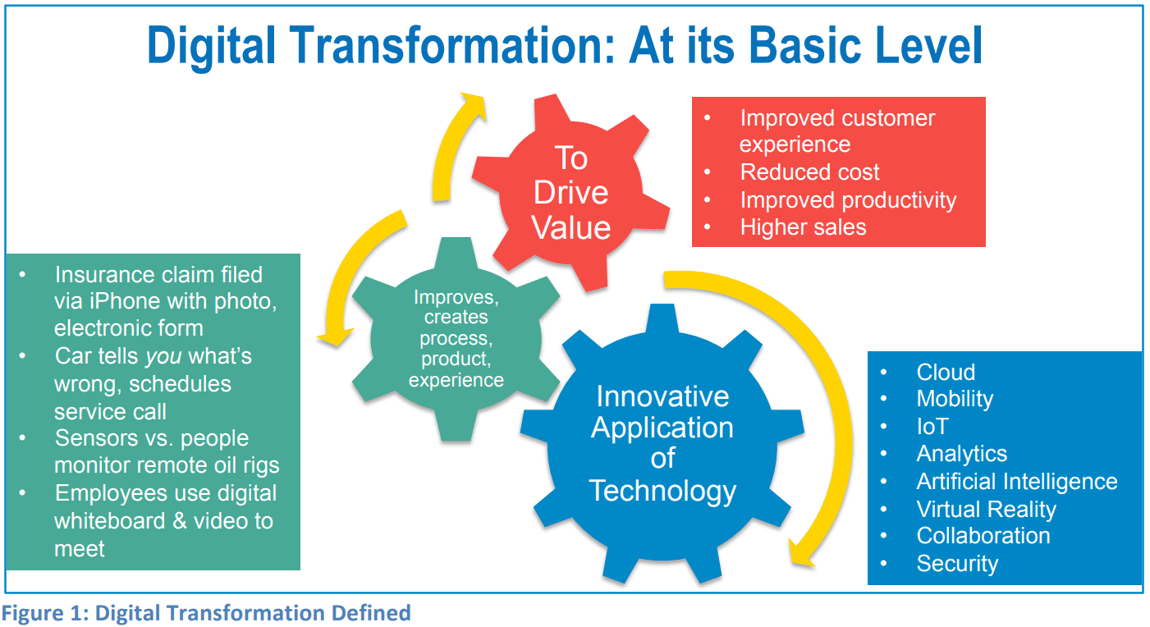
The technology can include a new application of existing products, services, or apps, or the implementation of entirely new products, services, or apps. (Please see Figure 1 for examples of such technologies.)
The application of that existing or new technology results in transformation—a new way for employees to work or communicate, a better way for customers to get what they need, or a faster way to get word to market about a new product, for example.
But in order to have a true digital transformation, measureable value must ultimately result from the changes. The value it drives can include any of the following:
- Generates revenue
- Reduces cost
- Increases employee productivity
- Improves customer experience
- Bolsters employee recruitment and loyalty.
Key Technologies Supporting Digital Transformation
Though we may read about the excitement surrounding artificial intelligence, virtual reality, or Internet of Things (IOT), the majority of successful digital companies focus on foundational technologies first to support the more advanced digital transformation initiatives. Foundational technologies include the network, cloud infrastructure, and UCC.
UCC, though, straddles both foundational and innovative technology. A strong foundation includes solid telecommunications capabilities, along with some basics, such as instant messaging, presence, and conferencing. Moving forward, organizations are exploring team collaboration, virtual whiteboards, and mobile enabled collaboration to further enhance interactions.
We asked IT leaders where they planned to increase spending in 2017. We then segmented the results by those who met our criteria for successful digital transformation organizations and those who did not. We highlighted the differences—and by what percentages—between those in the success group and those not. As shown in Figure 2, companies finding success with digital transformation plan to increase their spending on UCC 72% more than unsuccessful companies.
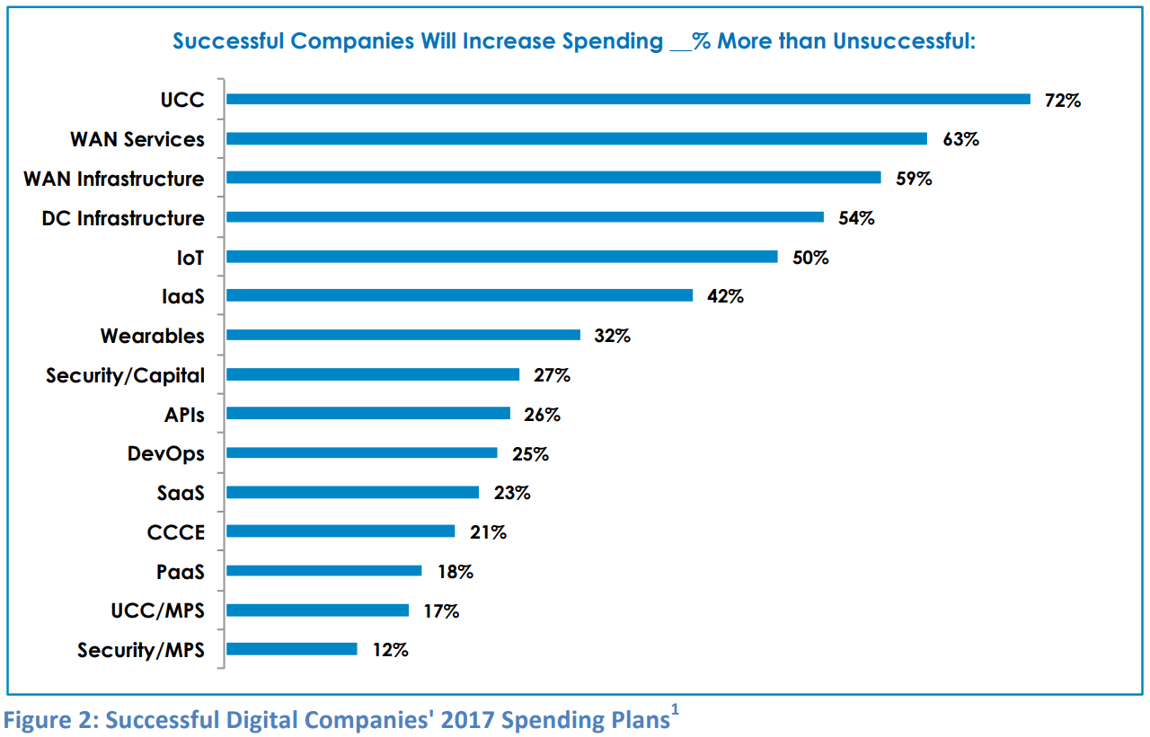
¹ CCCE = Contact Center and Customer Engagement; MPS = Managed and Professional Services
With UCC being so vital to organizations’ broader digital transformation initiatives, it’s imperative for the UCC products, apps, and services to operate at maximum efficiency.
UCC’s Vital Role in Transformation
All too often, we talk with IT leaders who are experiencing problems with their IP telephony or UC performance. Typically, these are on-premises deployments that relied only on the management and monitoring tools that come with the platform. However, platform providers do not specialize in management, nor do they typically manage across platforms in a multi-vendor environment, so the capabilities and reach are limited. Within one to two years, they realize they need additional tools to assist with root-cause analysis, predictive analysis, event management, and more.
Challenges to Effective Management
So why do IT leaders often bypass buying third-party management and monitoring tools if they can help them operate their communications infrastructures more effectively? And in doing so, what other challenges do they face? After conducting research with hundreds of IT professionals, Nemertes has characterized challenges in the following challenges:
- Awareness – Many organizations are unaware tools exist specifically to help manage real-time communications traffic. They’ve become accustomed to lengthy Mean Time To Repair (MTTR), consistent finger pointing among partners, and complaints from employees and customers when performance issues become too extreme.
- Budget – Given their lack of awareness and understanding of the effectiveness of tools, IT leaders rarely seek the budget to buy them—or have the time/staff to evaluate them. If they do request budget, it often gets denied because of the number of other tools already in use (network management, app management, event management, etc.) or the lack of a compelling business case justifying the spending.
- Discovery of problems – Most companies learn about problems with apps or networks through users calling the help desk or filing an electronic trouble ticket. By that time, the problem already has affected numerous customers, employee meetings, sales calls, etc.
- Determining root cause – Once they know a problem exists, they must figure out what is causing it—the call server, handset, circuit, application, or perhaps an interoperability issue. Time after time, administrators say they had to manually recreate the problems, pulling pieces of data from various tools to arrive at a root cause. This process rarely takes less than a few hours, and often takes days—or even weeks in a complex network or contact center.
- Repairing the problem – Determining root cause certainly helps with the actual repair. Often, though, IT leaders say they only found the general cause of the problem and needed more specific details to uncover the detailed cause. Service providers and vendors point fingers at one another because the root-cause analysis only points to a problem outside the network, and no one has the details to determine where outside the corporate network.
- Managing partner finger pointing – Without details about network and application performance, it takes numerous calls and refereeing between providers who each deny ownership of the problem.
- Improving customer experience – Customer experience has become a key competitive differentiator and one that has merited increasing attention in recent months. Proactive management can address problems before they become serious enough to affect customers. And, they can generate useful analytics to show which UCC apps are most widely used—and most successfully used, helping with employee training and improving the overall customer experience.
Given employees, customers, and partners all rely on UCC to communicate and collaborate, outages or slowdowns by definition will slow performance, directly affecting the value metrics so crucial to digital transformation initiatives. What’s more, as adoption of UCC increases, the pains that result from poor performance become ever more visible because more people are affected.
Cost of Downtime
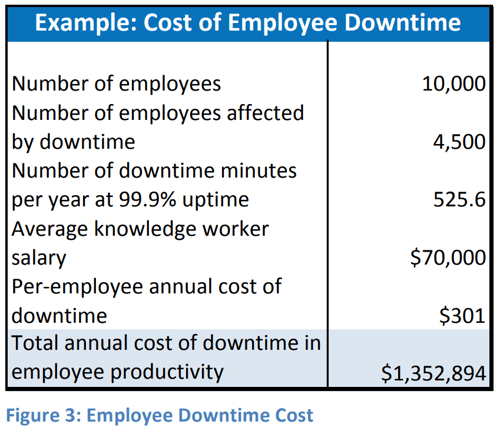
The cost of downtime adds up, yet when uptime numbers like 99.9% or even 99.999% get tossed around, the costs seem insignificant on the surface. Figures 3 and 4 illustrate the annual cost of downtime in two scenarios. Figure 3 shows productivity of employees. Some Chief Financial Officers discount these as “soft-dollar" costs that won't show up on a balance sheet, so they’re irrelevant. However, time equals money, particularly in highly competitive markets where automation is taking hold.
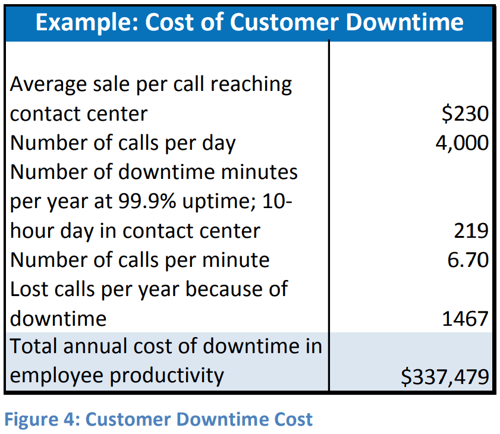
Figure 4 shows a more concrete example of a contact center, which generates on average $230 per call. Downtime affecting either the contact center itself, or the collaboration apps such as presence and IM to check with experts, directly affects sales.
Downtime extends into other measureable problem areas. For example, when contact-center channels do not work properly, customer satisfaction or Net Promoter scores may drop. When collaborative environments (video, virtual whiteboards, Team Collaboration, etc.) for product development don’t work well, that IT staffs can measure, product development times lengthen creating a competitive disadvantage. Downtime also can damage the brand, particularly if it’s happening regularly and customers start complaining on social media. If the issue degrades significantly, companies stand the chance of losing customers forever or a long time, affecting the average lifetime value of customers.
UCC Matters. Why Not Make Sure it Works Well?
Companies clearly pay for UCC downtime in hard dollars, customer satisfaction, or employee productivity. But making sure UCC performs efficiently helps prevent such problems—and specifically, reduces operational costs. Nemertes has tracked UCC Total Cost of Operations for 12 years through research projects annually with hundreds of organizations. We have consistently found that when organizations use specialty management and monitoring tools, their operational costs are substantially lower than those who do not use such tools.
Defining Performance Management, Providers
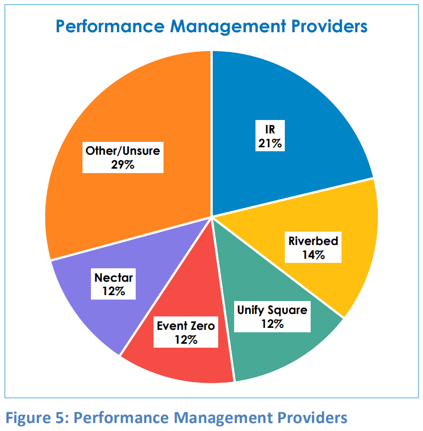 Before examining the numbers, let’s look at performance management and the players cited by IT leaders in our research. Performance management providers focus on uptime, problem/resolution, root-cause analysis, and ongoing performance of UCC apps. Our research indicates that 22.7% of IT professionals use these tools. However, among those with more than 2,500 UCC endpoints, that figure jumps to 55%.
Before examining the numbers, let’s look at performance management and the players cited by IT leaders in our research. Performance management providers focus on uptime, problem/resolution, root-cause analysis, and ongoing performance of UCC apps. Our research indicates that 22.7% of IT professionals use these tools. However, among those with more than 2,500 UCC endpoints, that figure jumps to 55%.
Figure 5 shows the specific providers cited in our research. Organizations use IR most frequently for performance management functions, followed by Riverbed, Unify Square, Event Zero, and Nectar. Several cited other providers, but none of those received enough responses to be counted individually.
Among the providers cited, three are multi-vendor (IR, Riverbed, and Nectar), and two are single vendor (Event Zero and Unify Square), specifically managing Microsoft.
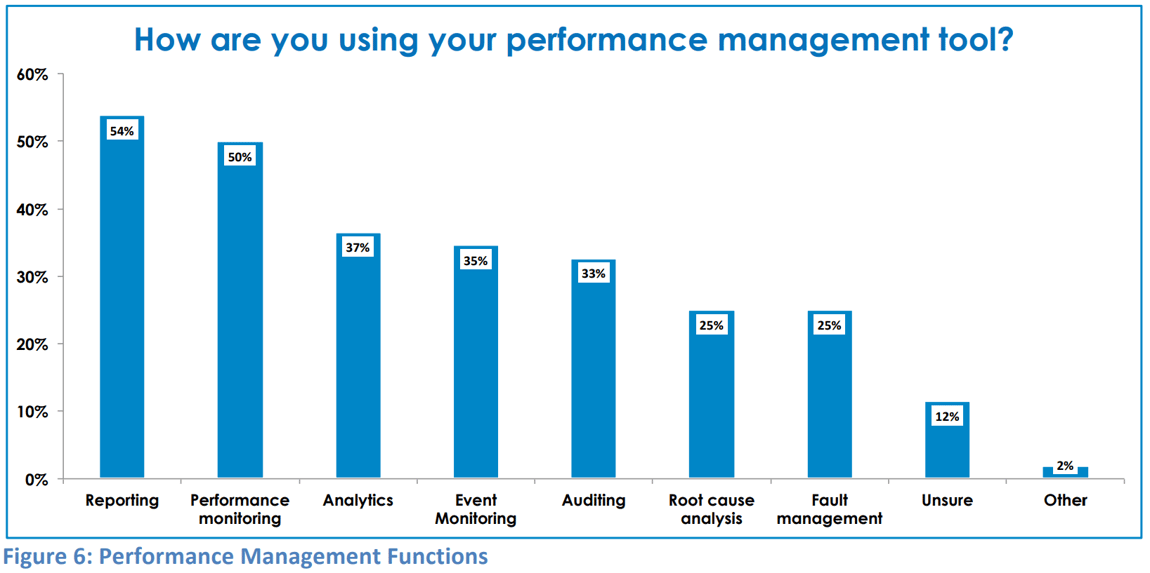
IT leaders rely on performance management for multiple functions, outlined in Figure 6. They use the tools most commonly for reporting, performance monitoring, and analytics. Other functions include event monitoring, auditing, root cause analysis, and fault management.
The goal of these tools is to help voice and UC apps running at optimal performance. When issues do occur, they aim to provide quick notification of a problem or pending problem, along with the analysis to narrow down and diagnose the cause of the problem. By preventing and shortening any outages or slowdowns, companies a.) have less downtime and reduce the problems cited earlier in the paper (lost sales, employee productivity drains, etc.); and b.) reduce the IT staffing requirements and other operational costs to operate the UCC infrastructure.
Significant Cost Savings With Management Tools
Ironically, IT leaders often say they could not get budget to buy specialty management tools. Yet, the tools themselves save significantly more than their cost. Overall, large organizations that use UCC performance management tools spend less than half on UCC operational costs than those that do not use performance management.
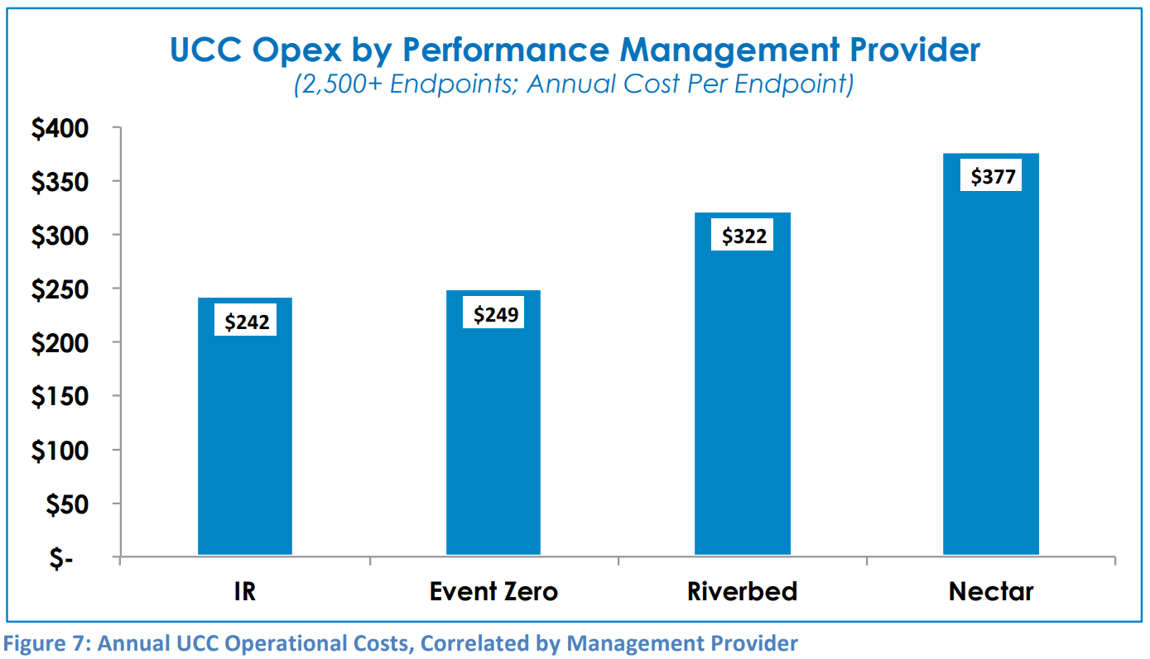
Four performance management providers garnered enough response to be counted individually in our research. When compared against one another, IR has the lowest operational cost per endpoint, followed by Event Zero (which only manages Microsoft environments), Riverbed, and Nectar. (Please see Figure 7.) To compare apples to apples, IR, Riverbed, and Nectar all manage multiple vendors. IR customers with 2,500 endpoints or more spend 33% less on UCC operational costs than Riverbed, and 56% less than Nectar.
In our general cost data research, we gather information on capital, implementation, and operational costs using the following metrics and calculations:
- Capital cost per endpoint: Includes PBX, endpoint devices and licenses, servers, other hardware. In some cases, bundled licenses include certain UC apps.
- = Capital costs / number of endpoints (handsets, softphones, etc.)
- Implementation cost per endpoint: Includes staff time and third-party consultants and integrators.
- = ((Staff time * loaded hourly rate)+third-party costs)/ number of endpoints
- Operational cost per endpoint: Includes staff time, equipment maintenance, third-party managed services, training and certification.
- = ((Number of FTEs * average annual loaded salary) + equipment maintenance + managed services + training/certification) / number of endpoints
Operational Cost Details
What makes up the operational costs, and how do they differ with and without the use of management tools? IT staffing costs, which make up the biggest percentage of operational costs, drops by 33% with the use of performance management tools overall. They also spend less on training, both user and IT, by 50%. IT training costs drop because fewer IT staff members must be trained (since fewer are needed thanks to the tools). User training drops because organizations devote more people to formal user awareness and adoption programs, which are run more effectively and efficiently.
Managed services drop to almost nothing with the use of performance management. The only component that increases is equipment maintenance, as the management tools themselves require maintenance.
Increased Adoption
In addition to lower operational costs, the use of performance management tools correlates with increased user adoption of UCC. Among companies with 2,500 or more endpoints, 94% of employees have UCC licenses when performance management is in use, vs. 72% when they do not use performance management.
Conclusion and Recommendations
As companies forge ahead with digital transformation initiatives, efficiently managed UCC is crucial to success. Nemertes recommends the following:
- Make sure business unit leaders understand the importance of UCC apps to their digital transformation initiatives. That will help to ensure funding for new and continued UCC apps.
- Evaluate and leverage UCC performance management tools early in your deployment to maximize operational cost savings.
- Performance-management tools helps to reduce the number of IT staff members you need running the day-to-day operations of UCC. Reassign those people or headcount to more strategic functions that ultimately drive value (i.e., increase revenue, decrease costs, improve productivity, etc.) for the company. These include business-technology liaisons, partner management, and user awareness and adoption programs.
Methodology
Nemertes conducted the 2017 Unified Communications and Collaboration Total Cost of Operations research from January through March 2017. We gathered 723 data points from a combination of interviews and surveys of IT leaders.
The IT leaders were required to have decision making authority or influence over IP telephony or UCC decisions. We defined the following technologies as part of UCC:
- External IP telephony
- Voice chat
- Instant messaging
- Presence
- Desktop video conferencing
- Audio conferencing
- Web conferencing
- Team collaboration
- Messaging
- Social software
In addition to the UCC apps, we also gathered data on cloud trends, management and monitoring tools, endpoints, SIP trunking and SBCs. We asked the IT leaders for detailed information on their costs related to UCC, as well as vendor selection, drivers, inhibitors, and more. We correlated data, where sample sizes allowed, by company size, provider, rollout size, and more.
Demographics
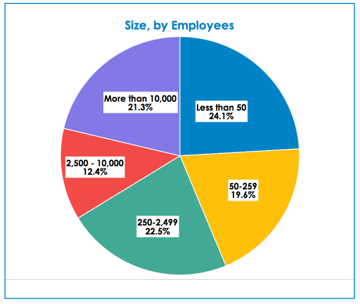 The study includes companies from all sizes and a variety of industries. Most companies are U.S.-based, and roughly 50% are global multinationals. The charts that follow show company size, by number of employees, average number of locations by size of company, industry, and titles of those included in the research.
The study includes companies from all sizes and a variety of industries. Most companies are U.S.-based, and roughly 50% are global multinationals. The charts that follow show company size, by number of employees, average number of locations by size of company, industry, and titles of those included in the research.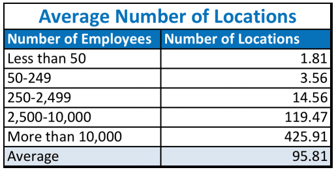
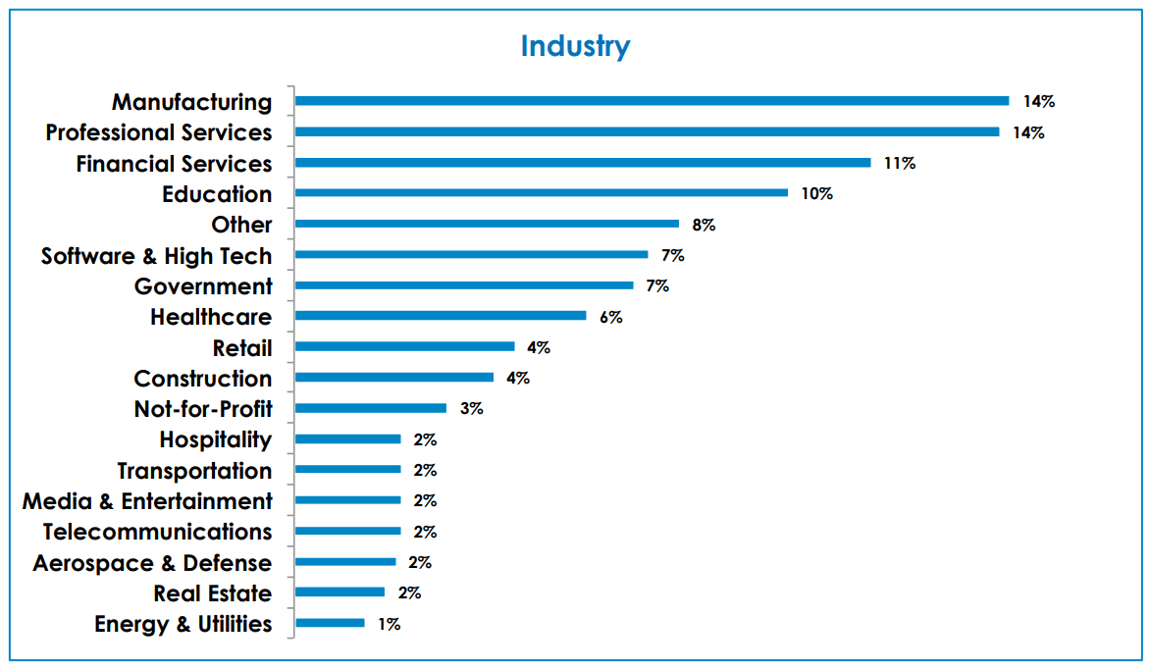
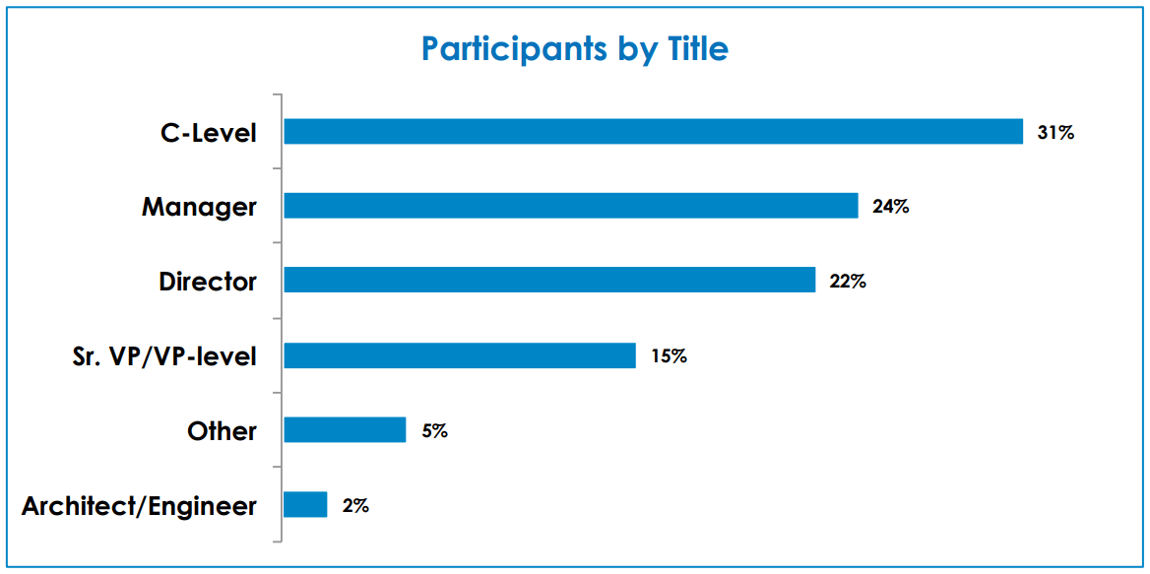
Download a PDF of the Nemertes Research Report on UCC Operational Costs

Download a PDF of the Nemertes Research Report on UCC Operational Costs
About Nemertes Research: Nemertes Research is a research-advisory and consulting firm that specializes in analyzing and quantifying the business value of emerging technologies. You can learn more about Nemertes Research at our Website, www.nemertes.com, or contact us directly at research@nemertes.com.




